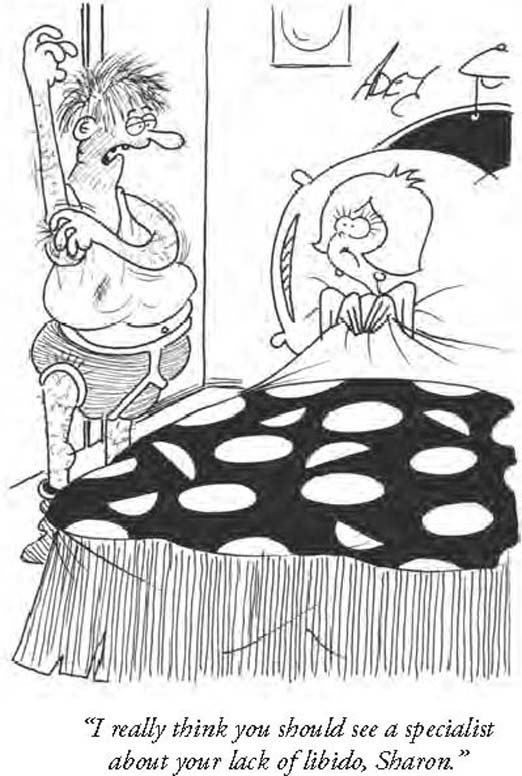10.4 The Trouble With Sex: Sexual Dysfunctions
NOT TONIGHT, BABE

 Ever since we had kids, my wife never seems to want sex. What can we do to rekindle her interest?
Ever since we had kids, my wife never seems to want sex. What can we do to rekindle her interest?
My boyfriend used to get really turned on by me, but now he seems to be more interested in Internet porn. What happened?
Low desire is the number one sexual problem facing Dr. Buehler’s clients. What’s behind the decline in libido? “It’s generally different for men and women,” Dr. Buehler says. Every case is unique, but a common explanation for low desire might be called The Woman Wearing Too Many Hats. “What I frequently find is that women have a need to be perfect in everything they do, and women also have a lot of demands put on them (or they put them on themselves),” Dr. Buehler explains. “They don’t leave any energy left over for pleasure.” So when their partners want sex, it just becomes another demand.
Is it possible a woman might be avoiding sex by packing her schedule with activities? Perhaps she does not derive much pleasure from sex (she may have trouble achieving orgasm), or maybe there is a problem in the relationship that makes her want to push away. Dr. Buehler is always on the lookout for relationship problems that have infiltrated the bedroom.
Dr. Buehler: How do you make sexual topics more approachable as a discussion?
Low libido is much less common in men, and when present, often results from low testosterone levels. If the problem isn’t biological, then there may be a relationship issue, Dr. Buehler explains. “The common terminology is passive-aggressive behavior,” she says. “You know, just not participating in sex as a way of communicating that ‘I’m not interested in being with you right now. I don’t like things that are going on in our relationship’.”
One of the most challenging scenarios, according to Dr. Buehler, is when the man has lower desire than the woman. This often leads to feelings of rejection on the woman’s part: He’s not into me anymore. He’s mad at me. He’s having an affair! “Everybody thinks it’s normal for men to have more desire, but you know, there are individual variations for both sexes,” Dr. Buehler explains. (The assumption that all men are sex machines is a prime example of a gender-role stereotype, a concept presented earlier in the chapter.) Some men want sex twice a day, whereas others are perfectly satisfied with once a week. “If everybody is happy and fulfilled,” Dr. Buehler notes, “it’s normal.”
Sexual Difficulties
LO 8 Identify the symptoms of sexual dysfunctions.
When there is a “significant disturbance” in the ability to respond sexually or to gain pleasure from sex, we call this sexual dysfunction (APA, 2013). In the National Health and Social Life Survey, researchers found 43% of women and 31% of men suffered from some sort of sexual dysfunction (Laumann, Paik, & Rosen, 1999). Everyday stressors or situational issues may cause temporary sexual difficulties, which can be resolved once the stress or the situation has passed.
Then there are the longer-term sexual difficulties, which can stem from a variety of issues, including beliefs about sex, ignorance about sexual practices, and even performance expectations. Health conditions can also give rise to sexual difficulties. The biopsychosocial perspective is invaluable for helping to untangle the roots of sexual problems.
Sexual dysfunctions may result from problems with desire, arousal, orgasm, and pain, but these are not mutually exclusive categories (TABLE 10.4). Let’s examine each one more carefully.
| Sexual Dysfunction | Description |
| Delayed ejaculation | Frequent delayed ejaculation or failure to ejaculate |
| Erectile disorder | Issues in getting or maintaining an erection, or a decrease in penile rigidity |
| Female orgasmic disorder | Consistent inability to reach orgasm, reduced orgasmic intensity, or not reaching orgasm quickly enough during sexual activity |
| Female sexual interest/arousal disorder | Reduced interest in sex, lack of initiation of sexual activity, lack of sexual excitement during sexual activity, or lack of genital sensations during sexual activity |
| Genito-pelvic pain/penetration disorder | Refers to four types of co-occurring symptoms specific to women: difficulty having intercourse, genito-pelvic pain, fear of pain or vaginal penetration, and tension of pelvic floor muscles |
| Male hypoactive sexual desire disorder | Reduced interest in and desire for sex, lacking or absent sexual/erotic thoughts or fantasies |
| Premature (early) ejaculation | Related to the timing of, or the inability to control, ejaculation when it occurs, specifically in relation to vaginal sex |
| Sexual dysfunction can stem from problems with desire, arousal, orgasm, and pain. Above are some of the most common sexual dysfunctions. | |
| SOURCE: APA (2013). | |
Desire
Situational issues such as illness, fatigue, or frustration with one’s partner can lead to temporary problems with desire. In some cases, however, lack of desire is persistent and distressing. Although low desire can affect both men and women, women tend to report desire problems more frequently than men (Brotto, 2010; Heiman, 2002).
Arousal
Problems with arousal occur when the psychological desire to engage in sexual behavior is there, but the body does not cooperate. Men may have trouble getting or maintaining an erection, or they may experience a decrease in rigidity, which is called erectile disorder (APA, 2013). More than half of all men report they have occasionally experienced problems with erections (Hock, 2012). Women can also struggle with arousal. Female sexual interest/arousal disorder is apparent in reduced interest in sex, lack of initiation of sexual activities, reduced excitement, or decreased genital sensations during sexual activity (APA, 2013).
Orgasm
Disorders related to orgasm are yet another category of dysfunction. Female orgasmic disorder is diagnosed when a woman is consistently unable to reach orgasm, has reduced orgasmic intensity, or does not reach orgasm quickly enough during sexual activity (APA, 2013). Men who experience frequent delay or inability to ejaculate might have a condition known as delayed ejaculation (APA, 2013; Segraves, 2010). With this disorder, the ability to achieve orgasm and ejaculate is inhibited or delayed during partnered sexual activity. Men who have trouble controlling when they ejaculate (particularly during vaginal sexual activity) may suffer from premature (early) ejaculation (APA, 2013).
Pain

The fourth category of sexual dysfunction is painful intercourse. Women typically report more problems with intercourse-related pain than men. Genito-pelvic pain/penetration disorder refers to four types of co-occurring symptoms specific to women: difficulty having intercourse, pain in the genitals or pelvis, fear of pain or vaginal penetration, and tension of the pelvic floor muscles (APA, 2013). Up to 15% of women in North America report frequent pain during intercourse, and issues related to pain are associated with reduced desire and arousal.
Sexual dysfunction is surprisingly common and often related to psychological and social variables such as anxiety and relationship troubles. The good news is that many of these conditions can be resolved with interventions that target their biological, psychological, and social roots. Unfortunately, we cannot say the same for some of the diseases transmitted through sex. As you will learn in the next section, some sexually transmitted infections have no cures.
show what you know
Question 10.14
1. Difficulties related to sexual activity can be divided into four categories:
- being heterosexual, homosexual, bisexual, and nonsexual.
- excitement, plateau, orgasm, and relaxation.
- desire, arousal, orgasm, and pain.
- desire, arousal, orgasm, and the sexual response cycle.
c. desire, arousal, orgasm, and pain.
Question 10.15
2. A man in his late fifties is concerned because he has occasional troubles with delayed ejaculation and his wife is not interested in sex. They have three small children and both work full time. Many of their friends are “empty nesters” whose grown children have moved out, and they seem to be celebrating their second honeymoons. Use the biopsychosocial perspective to help understand what might be contributing to this couple’s sexual problems.
Answers may vary, but could include biological factors (for example, age-related changes to physiology, hormonal changes, physical exhaustion), psychological factors (for example, balancing the stressors related to raising a family and working, raising young children), and social factors (for example, finding alone time to be together, feeling slightly jealous of friends who do not have small children at home, media influences).